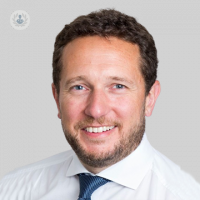What causes cholesteatoma?
Written in association with:A cholesteatoma is a cyst filled with dead skin cells that develops behind the eardrum. Award-winning otolaryngologist Professor Simon Lloyd explains what exactly causes the cyst and the best procedure for its removal.

What causes cholesteatoma?
In order to understand how cholesteatoma develops, it is necessary to understand a little bit about the anatomy and physiology of the ear. The ear has three main parts, the outer ear made up of the pinna and the ear canal, the middle ear made up of the eardrum and the air-filled space behind the eardrum, and the inner ear made up of the hearing organ (cochlea) and the balance organ (vestibular apparatus).
The middle ear is ventilated by a tube connecting it with the back of the nose. This is the Eustachian tube. Normally the Eustachian tube opens when you swallow but in some people, especially children, it does not open very well. If it doesn’t open very well, over time there is a tendency for the atmospheric pressure in the middle ear to drop because the lining of the middle ear tends to absorb gases from the air and the gases are not replaced adequately because of the poor Eustachian tube function. This negative pressure causes the eardrum to be sucked inwards. This is termed retraction.
The outer surface of the eardrum is lined with skin. Skin, as a natural process, tends to shed dead skin cells from its surface. Normally, in the ear, these dead skin cells migrate out of the ear canal with wax produced in the ear canal. If the eardrum becomes retracted, there is a lip around the edge of the retraction that the skin cannot migrate over. This means that the dead skin cells accumulate in the retracted part of the eardrum and, as the skin cells are constantly shed, they eventually build up into a cyst. This is the cholesteatoma.
Over time, the cholesteatoma gradually expands into the middle ear space and wraps itself around and damages the tiny hearing bones that are found in the middle ear. These hearing bones (called ossicles) carry sound to the inner ear and when they become damaged this carriage of sound is no longer possible. This is called a conductive hearing loss because sound cannot be conducted to the inner ear. It is therefore not uncommon for patients with a cholesteatoma to have a conductive hearing loss. It is also common for the cholesteatoma to get infected. This means that the ear discharges a smelly yellow or green liquid. Sometimes the ear can also be painful.
Cholesteatomas are able to eat away at bone, hence the damage to the hearing bones. The walls of the middle ear are bony and cholesteatomas can erode these walls and damage the structures that are adjacent to the middle ear. These structures include the cochlea and the balance organ, the facial nerve, the large veins draining the head of blood and the brain with damage leading to inner ear deafness, dizziness, weakness of the face, blood clots in the large veins and infection next to or within the brain (an abscess) or infection of the lining of the brain (Meningitis). Thankfully, however, cholesteatomas are slowly growing and this damage can take many years to develop. This fact, together with the use of antibiotics, means that these complications are rare these days.
How can cholesteatoma be removed using a fibre-guided laser?
The only way to properly deal with a cholesteatoma is to remove it. The surgery is technically challenging because of the structures that surround the middle ear. The overall term for operations to remove a cholesteatoma is mastoidectomy. It is called this because the bone behind the ear is called the mastoid and some of this bone has to be removed in order to get access to and remove the cholesteatoma. The bone is removed using a very fast, very sharp drill. Once this bone is removed and the cholesteatoma is exposed then removal of the cholesteatoma can start. This can be difficult (especially if the hearing bones are not yet damaged by the disease) because the cholesteatoma wraps around the hearing bones and grows into all the recesses in the middle ear (of which there are many).
Traditionally, it has been necessary to remove the hearing bones in most cases, even if they are still intact, in order to clear the cholesteatoma. This and the clearance of the disease from the recesses within the middle ear has, until recently, been carried out using various types of special instrument. Even with these special instruments, removing all the disease can be very difficult and potentially damaging to the structures around the ear, especially, the hearing organ. Additionally, even if a tiny amount of cholesteatoma is left behind it will grow back over time. The recurrence rate of cholesteatoma using traditional techniques is therefore around 20%.
What are the benefits of laser surgery for cholesteatoma?
Lasers produce a focussed beam of light that is very hot. It can be directed at the cholesteatoma down a glass fibre without the need to touch the underlying structures. The heat vaporises the dead skin cells and the lining of the cholesteatoma and prevents them from growing back. The laser beam can be directed into all the recesses around the ear and can access areas that traditional instruments are unable to access. Similarly, because it is not necessary to touch the underlying structures to remove the cholesteatoma there is less risk of damaging them. The use of the laser, therefore, reduces recurrence of cholesteatoma (from 20% down to 5%) and reduces the risk of complications. It also means that, if the hearing bones are not damaged by the disease, then the cholesteatoma can often be removed leaving the hearing bones intact. This means it is possible to maintain the natural hearing mechanism in some cases where we would otherwise not be able to. Because of these advantages, I introduced the laser into my practice for a few years.


